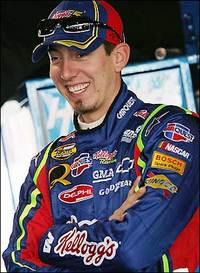KYLE BUSCH Bristol: It Can Make or Break a Championship
 |
HUNTERSVILLE, N.C. March 17, 2009: Only three of 35 races are complete in the 2009 NASCAR Nationwide Series season, but the results of race number four, Saturday’s Scotts Turf Builder 300 at Bristol (Tenn.) Motor Speedway, will no doubt have implications at November’s season-ending Ford 400 at Homestead-Miami Speedway.
Why is a race in March important in a marathon 35-race schedule? Because Bristol, with its high banks and tight confines, is a crapshoot. Drivers are routinely taken out in accidents not of their own making, and survival at the .533-mile track is key for any driver, especially those in the championship chase.
Consider that only one driver since 2003 has posted a finish outside the top-15 at Bristol and gone on to win the Nationwide Series championship. Martin Truex Jr., en route to the 2005 title, crashed in the spring race and finished 31st.
Every other champion in the last six years – Brian Vickers (2003), Truex (2004), Kevin Harvick (2006), Carl Edwards (2007) and Clint Bowyer (2008) has finished in the top-15 in both Bristol races en route to the title.
What does that mean for Kyle Busch and the No. 18 Z-Line Designs Toyota Camry team? It means that if they are going to compete for this year’s title, they need to come out of Bristol with little problems and notch a solid finish.
Busch has seven top-10 finishes in nine Nationwide Series starts at the .533-mile oval, including a win in the 2006 spring race. However, like so many others, he has felt the bite of Bristol as accidents caused him to finish 38th (fall 2005) and 42nd (spring 2008).
With three races down, Busch is fifth in Nationwide points and there is plenty of time left in the season. But as the past has proven, Bristol is a key component to any chance of championship success in November.
Kyle Busch, No. 18 Z-Line Designs NASCAR Nationwide Series Toyota Camry at Bristol Motor Speedway
Each race in a 35-race season is important, but why is success at Bristol important to a championship drive?
“Anything can happen there and you can get caught up in somebody else’s wreck. Things happen so fast there that sometime you don’t have anywhere to go. It’s not like the big tracks, where you might have the apron or the grass to avoid an accident. You just try to get in a rhythm, avoid the wrecks and put yourself in position to win at the end.”
What is the perfect balance for a race at Bristol?
“I think the perfect balance would be some good green-flag racing with a couple of green-flag stops, and yet still having some wrecks. With the racing that we have there – it’s pretty good racing there, now, with the three lanes. But you don’t see as much beating and banging for the one groove that we all had to fight for before because we can go anywhere, now. It’s good racing, but there’s less contact and more room to maneuver around, although you might see a little more of the bump-and-run stuff in the Nationwide Series cars as opposed to the Cup cars. I think the fans have their different opinions and you’re never going to be able to please everybody.”
Jason Ratcliff, crew chief of the No. 18 Z-Line Designs NASCAR Nationwide Series Toyota Camry at Bristol Motor Speedway
How important is the Bristol race to the championship hunt?
“You get the same amount of points as you do for any other race, but now, since the reconfigured Bristol, you see a lot fewer cautions than you did a couple of years ago because of the progressive banking. They’ve created a racetrack where you can run two- or three-wide. Before, you couldn’t pass a guy, so you had to ram him out of the way. You move him and then 20 other guys pile into him or you get caught in somebody else’s mess. You don’t have that as much, anymore, so you can breathe a little bit easier from a points standpoint. But, it’s still Bristol and any time you are in a short-track race, the level of intensity is a little higher. You just need to go in there and do your deal and put the best car you can on the racetrack, let the driver run his race and, hopefully, you stay out of trouble and come out with a win or a pretty healthy finish that pays good points.”
The weather in March at Bristol can be unpredictable. How does that affect you as a crew chief?
“Typically, the only frustrating part this time of year with Bristol is you don’t know what the weather is going to be like. A couple of years ago, we had to come back on Monday due to cold and snow, and the next year there was a snow delay in the race. So, you never know what to expect. From a car standpoint, it doesn’t seem to affect the racetrack. I think, with it being concrete, it’s not as sensitive. The track is consistent, so weather is not an issue, but it can shuffle the schedule around quite a bit.”
What is the most important thing for you as a crew chief to get your car to do at Bristol?
“Handle well. You have to be able to get through the center of the corner. You hear that a lot, but at Bristol, you have to be able to do that. We never lack for power, but you can be at a deficit from an engine standpoint
and still have a chance to win the race, because it’s not power down the straightaway that wins it. The big key is being able to roll through the center.”


